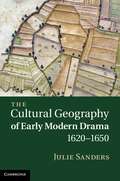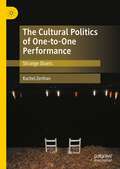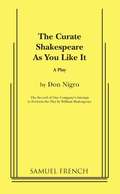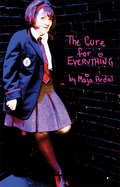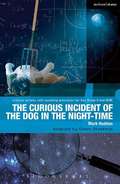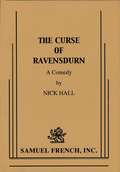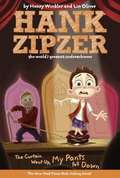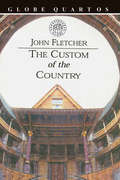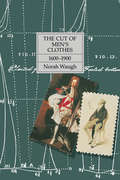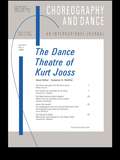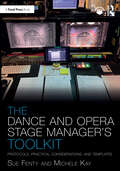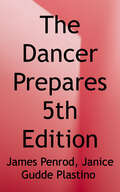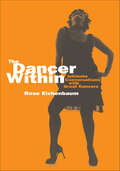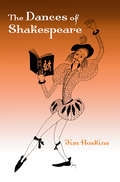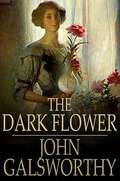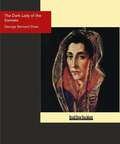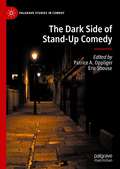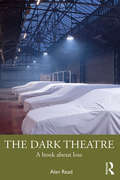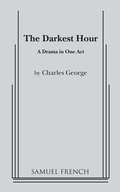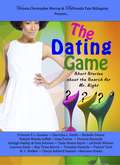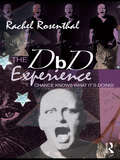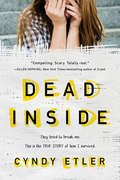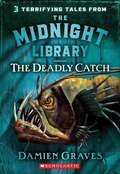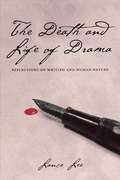- Table View
- List View
The Cryptogram
by David MametIn this gripping short play, David Mamet combines mercurial intelligence with genuinely Hitchcockian menace. The Cryptogram is a journey back into childhood and the moment of its vanishing--the moment when the sheltering world is suddenly revealed as a place full of dangers. On a night in 1959 a boy is waiting to go on a camping trip with his father. His mother wants him to go to sleep. A family friend is trying to entertain them--or perhaps distract them. Because in the dark corners of this domestic scene, there are rustlings that none of the players want to hear. And out of things as innocuous as a shattered teapot and a ripped blanket, Mamet re-creates a child terrifying discovery that the grownups are speaking in code, and that that code may never be breakable.
The Cultural Geography of Early Modern Drama, 1620–1650
by Julie SandersLiterary geographies is an exciting new area of interdisciplinary research. Innovative and engaging, this book applies theories of landscape, space and place from the discipline of cultural geography within an early modern historical context. Different kinds of drama and performance are analysed: from commercial drama by key playwrights to household masques and entertainment performed by families and in semi-official contexts. Sanders provides a fresh look at works from the careers of Ben Jonson, John Milton and Richard Brome, paying attention to geographical spaces and habitats like forests, coastlines and arctic landscapes of ice and snow, as well as the more familiar locales of early modern country estates and city streets and spaces. Overall, the book encourages readers to think about geography as kinetic, embodied and physical, not least in its literary configurations, presenting a key contribution to early modern scholarship.
The Cultural Politics of One-to-One Performance: Strange Duets
by Rachel ZerihanThis monograph is the first study to critically examine works of performance made for an audience of one. Despite being a prolific feature of the performance scene since the turn of the millennium, critical writing about this area of contemporary practice remains scarce. This book proposes a genealogy of the curious relationship between solo performer and lone spectator through lineages in the histories of live art, visual art and theatre practices. Drawing on one-to-one performances by artists including Marilyn Arsem, Oreet Ashery, Franko B, Rosana Cade, Jess Dobkin, Karen Finley, David Hoyle, Adrian Howells, Kira O’Reilly, Barbara T Smith and Julie Tolentino, Rachel Zerihan produces research that is both affective and critical. This performance analysis proposes four frameworks through which to examine the significance and challenge of this work: cathartic, social, explicit and economic. One-to-one performance is proposed as a rich portal for examining the cultural politics of contemporary society. The book will appeal to students and scholars from performance studies, theatre, visual art and cultural studies.
The Curate Shakespeare As You Like It
by Don NigroComedy / 4m, 3f / This unusual piece is subtitled "The record of one company's attempt to perform the play by William Shakespeare". When the prolific Mr. Nigro was asked by a professional theatre company to adapt As You Like It so that it could be performed by a company of seven, he devised a completely original play about a rag tag group of players led by a dotty old curate who must present Shakespeare's play. The dramatic interest and the comedy derive from their hilarious attempts to impersonate all of Shakespeare's characters. The play has had numerous productions nationwide and has become an underground comic classic.
The Cure for Everything
by Maja ArdalElsa is a typical fifteen-year-old growing up in the early 1960s. Her world revolves around independence, boys, and being popular at school, despite growing concerns surrounding the Cuban missile crisis. In fact, this is Elsa's opportunity to let loose before the world blows up. Knee-deep in teenage angst, her mission is clear: get drunk for the first time and lose her virginity. Though Elsa is old enough to feel the tense political climate, she is young enough to believe there might be a cure for everything. A comedic and compassionate sequel to Ardal's award-winning You Fancy Yourself, The Cure for Everything is a coming-of-age story about a teenager who discovers that the world is more complex than she could have imagined.
The Curious Incident Of The Dog In The Night-time
by Ruth Moore Mark Haddon Simon Stephens Paul BunyanThis schools' edition of Mark Haddon's multi-award-winning novel adapted for the stage of the National Theatre by Simon Stephens is perfect for Key Stages 3 and 4. Christopher, fifteen years old, stands beside Mrs Shears's dead dog. It has been speared with a garden fork, it is seven minutes after midnight, and Christopher is under suspicion. He records each fact in the book he is writing to solve the mystery of who murdered Wellington. He has an extraordinary brain and is exceptional at maths, but he is ill-equipped to interpret everyday life. He has never ventured alone beyond the end of his road, he detests being touched and he distrusts strangers. But Christopher's detective work, forbidden by his father, takes him on a frightening journey that turns his world upside-down. This educational edition in Methuen Drama's Critical Scripts series has been prepared by national Drama in Secondary English experts Ruth Moore and Paul Bunyan. Building on a decade of highly effective work and publications endorsed by national organisations and supported by teachers and consultants across Britain, each book in the series: meets the requirements at KS3 and GCSE features detailed, structured schemes of work utilising drama approaches to improve literary and language analysis places pupils' understanding of the learning process at the heart of the activities will help pupils to boost English GCSE success and develop high-level skills at KS3 will save teachers considerable time devising their own resources. Simon Stephens's adaptation of Mark Haddon's bestselling, award-winning novel, The Curious Incident of the Dog in the Night-time offers a richly theatrical exploration of this touching and bleakly humorous tale.
The Curse Of Ravensdurn (Short Plays)
by Nick HallThis full length play is comprised of six short plays in two acts. Act I - "The Ninteenth Century": Night Caps , Padparadsha , and Curse of the Ravensdurn. Act II - "The Twentieth Century": The Claimant , Ravensdurn Remains and Caveat Emptor . These six short plays by the author of Around the Clock and other popular plays tell the history of the most hideous, hilarious stately home in England. Ghosts, secret passages, romance, fortune hunters, big game hunters, stolen jewels, a heathen idol, a missing heir, faithful butlers, unfaithful butlers, murder, betrayal, Americans and thunder and lightning-lots of thunder and lightening-enliven these affectionate but macabre tales of one hysterically cursed family.
The Curtain Went Up, My Pants Fell Down (Hank Zipzer, the World's Greatest Underachiever #11)
by Henry Winkler Lin OliverHank Zipzer is failing math, so he has to work with Heather Payne, resident class brain, to help get his grades up. At the same time, Hank’s school is putting on a production of The King and I. As coincidence would have it, Hank is cast as the King, and Heather as Anna. But when Hank’s dad tells him he can only appear in the play if he gets a B on his next math test, Hank knows he has to hit the books. Can Hank pull through in time for the show?
The Custom of the Country: The Custom Of The Country. Elder Brother. Spanish Curate. Wit Without Money. Beggars' Bush (Globe Quartos)
by John FletcherFirst Published in 1999. Routledge is an imprint of Taylor & Francis, an informa company.
The Cut of Men's Clothes: 1600-1900
by Norah WaughThis book traces the evolution of the style of men's dress through a sequence of diagrams accurately scaled down from patterns of actual garments, many of them rare museum specimens. The plates have been selected with the same purpose. Some are photographs of suits for which diagrams have also been given; others, reproduced from paintings and old prints, show the costume complete with its accessories. Quotations from contemporary sources--from diaries, travelers' accounts and tailors' bills--supplement Norah Waugh's text with comments on fashion and lively eyewitness descriptions.
The Dance Theatre of Kurt Jooss
by Suzanne WaltherFirst Published in 1997. Routledge is an imprint of Taylor & Francis, an informa company.
The Dance and Opera Stage Manager's Toolkit: Protocols, Practical Considerations, and Templates (The Focal Press Toolkit Series)
by Susan Fenty Studham Michele KayThe Dance and Opera Stage Manager’s Toolkit details unique perspectives and approaches to support stage managers beginning to navigate the fields of dance and opera stage management in live performance.This book demystifies the genre-specific protocols and vocabularies for stage managers who might be unfamiliar with these fields and discusses common practices. Filled with valuable industry-tested tools, templates, and practical information, The Dance and Opera Stage Manager’s Toolkit is designed to assist stage managers interested in pursuing these performance genres. The book also includes interviews and contributions from a range of professional stage managers working in dance and opera.From the student stage manager studying in Theatrical Design and Production university programs to the experienced stage manager wanting to broaden their skill set, this book provides resources and advice for a successful transition into these worlds.The Dance and Opera Stage Manager’s Toolkit includes access to an online repository of resources and paperwork examples to help jumpstart the reader’s journey into dance and opera stage management. To access these resources, visit www.routledge.com/9780367566579.
The Dancer Prepares: Modern Dance for Beginners
by James Penrod Janice Gudde PlastinoDesigned for beginning and intermediate courses, this accessible, easy-to-read text provides students with concrete, practical information on both the technical and creative aspects of modern dance. It also covers the basics of anatomy, including posture and injury concerns.
The Dancer Within: Intimate Conversations with Great Dancers
by Rose EichenbaumThe Dancer Within is a collection of photographic portraits and short essays based on confessional interviews with forty dancers and entertainers, many of them world-famous. Well-known on the concert stage, on Broadway, in Hollywood musicals, and on television, the personalities featured in this book speak with extraordinary candor about all stages of the dancer's life—from their first dance class to their signature performances and their days of reflection on the artist's life. The Dancer Within reveals how these artists triumphed, but also how they overcame adversity, including self-doubt, injuries, and aging. Most of all, this book is about the courage, commitment, love, and passion of these performers in their quest for artistic excellence. The reader will quickly realize that "the dancer within" is a metaphor of the human spirit.
The Dances of Shakespeare
by Jim HoskinsFirst Published in 2005. Routledge is an imprint of Taylor & Francis, an informa company.
The Dark Flower
by John GalsworthyThe keen insight and multidimensional characters that enliven the works of English novelist John Galsworthy, such as The Forsyte Saga, are also brought to bear in The Dark Flower. This emotionally gripping tale focuses on the intertwined fates of four women, each of whom is facing a critical juncture in her life.
The Dark Lady of the Sonnets
by Bernard ShawThe Dark Lady of the Sonnets is a 1910 short comedy by George Bernard Shaw in which William Shakespeare, intending to meet the "Dark Lady", accidentally encounters Queen Elizabeth I and attempts to persuade her to create a national theatre.
The Dark Side of Stand-Up Comedy (Palgrave Studies in Comedy)
by Patrice A. Oppliger Eric ShouseThis book focuses on the “dark side” of stand-up comedy, initially inspired by speculations surrounding the death of comedian Robin Williams. Contributors, those who study humor as well as those who perform comedy, join together to contemplate the paradoxical relationship between tragedy and comedy and expose over-generalizations about comic performers’ troubled childhoods, addictions, and mental illnesses. The book is divided into two sections. First, scholars from a variety of disciplines explore comedians’ onstage performances, their offstage lives, and the relationship between the two. The second half of the book focuses on amateur and lesser-known professional comedians who reveal the struggles they face as they attempt to hone successful comedy acts and likable comic personae. The goal of this collection is to move beyond the hackneyed stereotype of the sad clown in order to reveal how stand-up comedy can transform both personal and collective tragedies by providing catharsis through humor.
The Dark Theatre: A Book About Loss
by Alan ReadThe Dark Theatre is an indispensable text for activist communities wondering what theatre might have to do with their futures, students and scholars across Theatre and Performance Studies, Urban Studies, Cultural Studies, Political Economy and Social Ecology. The Dark Theatre returns to the bankrupted warehouse in Hope (Sufferance) Wharf in London’s Docklands where Alan Read worked through the 1980s to identify a four-decade interregnum of ‘cultural cruelty’ wreaked by financialisation, austerity and communicative capitalism. Between the OPEC Oil Embargo and the first screening of The Family in 1974, to the United Nations report on UK poverty and the fire at Grenfell Tower in 2017, this volume becomes a book about loss. In the harsh light of such loss is there an alternative to the market that profits from peddling ‘well-being’ and pushes prescriptions for ‘self-help’, any role for the arts that is not an apologia for injustice? What if culture were not the solution but the problem when it comes to the mitigation of grief? Creativity not the remedy but the symptom of a structural malaise called inequality? Read suggests performance is no longer a political panacea for the precarious subject but a loss adjustor measuring damages suffered, compensations due, wrongs that demand to be put right. These field notes from a fire sale are a call for angry arts of advocacy representing those abandoned as the detritus of cultural authority, second-order victims whose crime is to have appealed for help from those looking on, audiences of sorts.
The Darkest Hour
by Charles GeorgeDrama / 3m, 2f / One of the most powerful stories ever condensed into a one act play, The Darkest Hour tells the story of young John Madison, within four hours of his execution for murder, having been found guilty on circumstantial evidence. He is innocent, but has no way of proving it, as appearances have been too strongly against him. His sorrowing mother comes to pay her last visit before the State exacts its toll. He reiterates his innocence and relates the entire circumstances to her in this heartbreaking tale.
The Dating Game: Short Stories About the Search for Mr. Right
by Richelle Denise Cheritta L. Smith Cheryl Ashford Daniels Gina Johnson Gina Torres Kay Trina Morris Keleigh Hadley Loureva Slade M. C. Walker Marcena Hooks Natalie Woods Leffall Patrice Tartt Princess F.L. Gooden Tania Renee Zayid Trenekia Danielle Victoria Kennedy LaChelle WeaverFrom fairytale romances to dating disasters and everything in between, The Dating Game chronicles the stories of hopefuls on their journey toward happily ever after. In this compilation of dating stories, sixteen writers share tales of adventures and experiences while on the quest toward finding Mr. Right. From Tania Renee Zayid 's story of what happens when one woman becomes determined to keep the perfect man that she met online . . . to Natalie Leffall's hilarious look into the dating world of a plus-size girl . . . to Keleigh and Gina's rib-tickling and surprisingly dangerous, speed dating fiasco. . . and Gina Torres' tale of love, heartache, and the power of letting go . . . these diverse stories will make you laugh, cry, and root for the characters to land Mr. Right.
The DbD Experience: Chance Knows What it's Doing!
by Rachel RosenthalFirst, pick up a copy of Rachel Rosenthal’s inspiring The DbD Experience; Part manual, part manifesto, part memoir, then head for Los Angeles… FRIDAY - OriginsArrive at the Doing by Doing workshop to be greeted by Rosenthal, pioneering theatre explorer and your host for the weekend ahead. Explore non-human ways of living and moving. Begin to develop a shared vocabulary with your fellow students through exercises. SATURDAY - ConnectionsContinue to connect with the group on an energetic level. Make the journey from Kansas to OZ. Collaborate and create as a group, moving and vocalising without language. Improvise boldly at every step. Treat music, voice, lighting, costume, sets, props and fellow performers as equals. SUNDAY - PowerLearn to arrive in the moment when you are needed. Engage with transformative processes and take part in the Star Meditation. Understand your own individual power, joining your physical and emotional self. Perform solo improvisations and the Rambler – the final, extended culmination of everything that you have learned through the 34 hour experience.
The Dead Inside: A True Story
by Cyndy EtlerFor readers of Girl Interrupted and Tweak, Cyndy Etler's gripping memoir gives readers a glimpse into the harrowing reality of her sixteen months in the notorious "tough love" program the ACLU called "a concentration camp for throwaway kids."I never was a badass. Or a slut, a junkie, a stoner, like they told me I was. I was just a kid looking for something good, something that felt like love. I was a wannabe in a Levi's jean jacket. Anybody could see that. Except my mother. And the professionals at Straight.From the outside, Straight Inc. was a drug rehab. But on the inside it was...well, it was something else.All Cyndy wanted was to be loved and accepted. By age fourteen, she had escaped from her violent home, only to be reported as a runaway and sent to a "drug rehabilitation" facility that changed her world.To the public, Straight Inc. was a place of recovery. But behind closed doors, the program used bizarre and intimidating methods to "treat" its patients. In her raw and fearless memoir, Cyndy Etler recounts her sixteen months in the living nightmare that Straight Inc. considered "healing."
The Deadly Catch (The Midnight Library #8)
by Damien Graves1. Adam and David go canoeing. Trouble awaits them in the water. The hungry kind of trouble. 2. Katie screams when she sees a mouse. And another one. And another one. And another one. 3. Kelly pursues a dream role in the school play. Offstage, her life is becoming a nightmare.
The Death and Life of Drama: Reflections on Writing and Human Nature
by Lance LeeWhat makes a film "work," so that audiences come away from the viewing experience refreshed and even transformed in the way they understand themselves and the world around them? In The Death and Life of Drama, veteran screenwriter and screenwriting teacher Lance Lee tackles this question in a series of personal essays that thoroughly analyze drama's role in our society, as well as the elements that structure all drama, from the plays of ancient Athens to today's most popular movies. Using examples from well-known classical era and recent films, Lee investigates how writers handle dramatic elements such as time, emotion, morality, and character growth to demonstrate why some films work while others do not. He seeks to define precisely what "action" is and how the writer and the viewer understand dramatic reality. He looks at various kinds of time in drama, explores dramatic context from Athens to the present, and examines the concept of comedy. Lee also proposes a novel "five act" structure for drama that takes account of the characters' past and future outside the "beginning, middle, and end" of the story. Deftly balancing philosophical issues and practical concerns, The Death and Life of Drama offers a rich understanding of the principles of successful dramatic writing for screenwriters and indeed everyone who enjoys movies and wants to know why some films have such enduring appeal for so many people.

